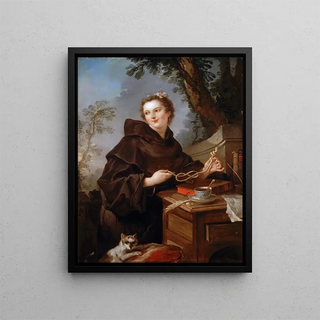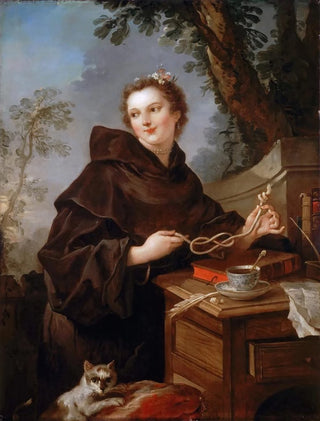Art print | Louise-Anne de Bourbon Mademoiselle de Charolais - Charles-Joseph Natoire Source: Reproduction | Louise-Anne de Bourbon mademoiselle de Charolais - Charles-Joseph Natoire


View from behind

Frame (optional)
In the rich and captivating world of 18th-century French art, the art print "Louise-Anne de Bourbon mademoiselle de Charolais" by Charles-Joseph Natoire stands out for its delicacy and elegance. This painting, emblematic of an era when court and nobility distinguished themselves through their refinement, captures not only the beauty of its subject but also the essence of a society in full transformation. Louise-Anne de Bourbon, a member of high nobility, is depicted in all her splendor, offering a precious glimpse into the customs and values of her time. Contemplating this work, the viewer is transported to a world where art and life blend harmoniously, revealing the aspirations and concerns of a cultivated elite.
Style and uniqueness of the work
Natoire's style is characterized by a keen attention to detail and a mastery of colors that give his portraits an almost lifelike dimension. In "Louise-Anne de Bourbon mademoiselle de Charolais," he manages to capture not only the physical appearance of his model but also her character and personality. The composition is carefully arranged, with each element chosen to emphasize the grace and poise of the young woman. The drapery of her dress, the delicate nuances of her skin, and the subtle expression on her face all testify to exceptional craftsmanship. Natoire uses light to highlight Louise-Anne's features, creating an intimate atmosphere that invites contemplation. This work is not limited to a simple portrait; it becomes a true visual narrative, an open window into a bygone era.
The artist and his influence
Charles-Joseph Natoire, born in 1700, is one of the most influential painters of his time, having mastered the balance between tradition and innovation. Trained at the Royal Academy of Painting and Sculpture, he developed a style that combines classicism with a nascent romantic sensitivity. Natoire was a key figure in the evolution of portraiture in the 18th century, influencing many contemporary and future artists. His ability to depict nobility with such finesse made him a favored figure in his era.

Matte finish

View from behind

Frame (optional)
In the rich and captivating world of 18th-century French art, the art print "Louise-Anne de Bourbon mademoiselle de Charolais" by Charles-Joseph Natoire stands out for its delicacy and elegance. This painting, emblematic of an era when court and nobility distinguished themselves through their refinement, captures not only the beauty of its subject but also the essence of a society in full transformation. Louise-Anne de Bourbon, a member of high nobility, is depicted in all her splendor, offering a precious glimpse into the customs and values of her time. Contemplating this work, the viewer is transported to a world where art and life blend harmoniously, revealing the aspirations and concerns of a cultivated elite.
Style and uniqueness of the work
Natoire's style is characterized by a keen attention to detail and a mastery of colors that give his portraits an almost lifelike dimension. In "Louise-Anne de Bourbon mademoiselle de Charolais," he manages to capture not only the physical appearance of his model but also her character and personality. The composition is carefully arranged, with each element chosen to emphasize the grace and poise of the young woman. The drapery of her dress, the delicate nuances of her skin, and the subtle expression on her face all testify to exceptional craftsmanship. Natoire uses light to highlight Louise-Anne's features, creating an intimate atmosphere that invites contemplation. This work is not limited to a simple portrait; it becomes a true visual narrative, an open window into a bygone era.
The artist and his influence
Charles-Joseph Natoire, born in 1700, is one of the most influential painters of his time, having mastered the balance between tradition and innovation. Trained at the Royal Academy of Painting and Sculpture, he developed a style that combines classicism with a nascent romantic sensitivity. Natoire was a key figure in the evolution of portraiture in the 18th century, influencing many contemporary and future artists. His ability to depict nobility with such finesse made him a favored figure in his era.






